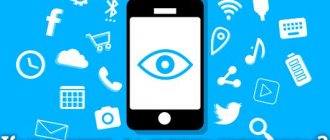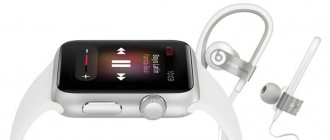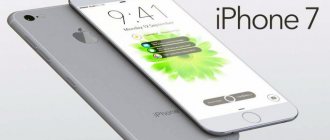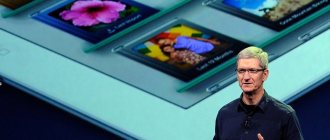Creating a computer for everyone is the idea with which Steve Jobs began building his business. On the way to success, the inventor made Pixar one of the most successful animation studios, founded the NeXT company and, of course, the Apple empire. Steve has been called the father of the “digital revolution,” but his complex nature and desire for excellence often prevented him from moving forward. Let's talk about different aspects of the life of one of the greatest entrepreneurs of our time.
Silicon Valley
Steven Paul Jobs was born in 1955 in San Francisco, California. His father Abdulfattah Jandali was from Syria, and his mother Joan Schible was the daughter of German emigrants. The Young Students' Union was not approved by the families, so Steve was given up for adoption. Adoptive parents Paul and Clara Jobs moved the boy to the city of Mountain View, located in Santa Clara County. It has become known as "Silicon Valley" due to the abundance of headquarters of many high-tech companies and corporations. As a result, young Stephen grew up next door to engineers working on electronics and other devices. This shaped his personality and developed his interest in the field.
At Mona Loma School, Steve's inquisitive mind was combined with a very bad character. He did not like the school rules and a number of disciplines that were uninteresting to him, which is why the boy regularly had conflicts with teachers. But young Jobs had a patron - a teacher named Mrs. Hill. Seeing considerable talent coupled with a complex character, she set herself the goal of correcting the child. To do this, she had to stimulate Steve with sweets, chocolate and, most importantly, kits for independent work. And all this for the sake of the boy finally coming to his senses and paying attention to other disciplines. And so it happened: exemplary behavior and excellent grades corrected Jobs' reputation. The results were so excellent that the school director advised the child to be transferred from the fourth grade directly to the seventh grade at the Crittenden school. Steve's parents asked him to limit himself to the sixth grade of high school, so that the already characteristic child would not become arrogant.
Problems arose immediately, since the school in Kittenden was located in a disadvantaged area where there were many juvenile hooligans. Steve got it both at school and outside of it. Having received enough punches, the boy began to beg his parents to transfer to another school. The last savings were spent on purchasing a house in the prosperous Los Altos area, and the child went to Homestead School in Cupertino.
When Jobs was just 13 years old, he called Hewlett-Packard co-founder and president William Hewlett to ask for parts for a school project. Impressed by such a brave act, he not only gave him spare parts, but also offered him an internship at the company. There Jobs met and became friends with Steve Wozniak.
Current iPhone models
Today, of course, there seems to be nothing surprising about the success of Apple, and no one doubts its further development. By releasing new devices, the corporation constantly improves them, due to which it still keeps its millions of fans hooked. It is amazing that even cheaper mobile devices on other operating systems cannot compare in terms of sales with Apple ones. This is a mystery of its own, because the laws of the market state that cheaper goods are more in demand. As the experience of the creator of the iPhone shows, this is not so.
Steve Jobs's first projects
After graduating from high school, Jobs attended Reed College in Portland, Oregon, but dropped out after one semester. He was fascinated by Eastern spiritualism and worked part-time on video games for Atari to pay for a trip to India. In 1974, he went there in search of enlightenment. A declassified FBI report states that Steve was using marijuana and LSD at the time, and once told a reporter that LSD was "one of the two or three most important things" in his life.
When Stephen returned to the United States, he again met with Wozniak, who was trying to create a compact computer. For Wozniak it was just a hobby, but the visionary Jobs realized the marketing potential of such a device and convinced his partner to open a joint business. In 1975, they founded a store in their parents' garage, calling the business Apple. To raise the first capital of $1,350, Jobs sold his Volkswagen minibus, and Wozniak sold his Hewlett-Packard calculator.
Even though the first Apple I prototype was sold mainly to hobbyists, friends made enough money to improve the design. In 1977, they introduced the Apple II, the first personal computer with color graphics and a keyboard.
Help AT&T sell iPhone
To realize his idea, the creator of the iPhone enlisted the support of AT&T, the largest mobile operator in the United States at that time. This was a new practice in relations between phone manufacturers and operators, since previously the latter dictated their terms, in fact, placing orders for mobile devices. In this situation, it was the other way around: AT&T CEO Stan Sigman believed in Jobs's idea and that it could work due to its originality, and the operator ultimately agreed to offer the phones under a contract that the buyer had to enter into. iPhones were offered in addition to communication services.
Discord in the team
By 1980, competition was intensifying, and sales of the new third version were falling. Then Steve introduced the Lisa computer, named after his daughter with Chris Ann Brennan. However, he did not acknowledge his paternity and denied that the name had anything to do with the girl's name. In any case, this version was also not accepted.
Everything changed when Jobs went on a tour of the Xerox PARC laboratory. He saw scientists working to develop the graphical user interface (GUI) and mouse, Ethernet, laser printing, and object-oriented programming. Jobs became obsessed with GUIs. As they say now, he brazenly “stole developments” from Xerox and incorporated them into his invention.
In 1984, Steven Jobs introduced the Macintosh, named after America's favorite apple variety. The first personal computer with a graphical interface and controlled by a mouse was a real breakthrough. But even here the engineer met with failure. The cost of $2,495 was too high for the average consumer. Sales were falling, and Steve refused to admit the mistake. Tensions with CEO John Sculley led Jobs to leave the company.
Work on Pixar and NeXT
Steve was terrified - Apple was his life. But after four months of traveling and searching for new ideas, he went away and returned with a new plan. Steve founded the NeXT company, which develops a computer platform for universities. He sold all but one of his Apple shares.
“I am convinced that half of what separates successful entrepreneurs from unsuccessful ones is persistence,” Jobs said.
That same year, an enterprising businessman bought a company specializing in computer animation from director George Lucas. Together with a team of specialists, he remade it and gave it the name Pixar. He spent his first five years selling equipment, but the studio's 1989 cartoon unexpectedly won an Oscar. It was a short video called "Tin Toy". RenderMan, a 3D animation product, was soon released. Thanks to him, Pixar made commercials that Disney drew attention to. The result was the familiar Toy Story. After the release of the cartoon, Steve's capital, which owned 80% of the company, grew to more than $1.5 billion.
The Mystery of Steve Jobs
Steve's character was difficult. The book "Steve Jobs: A Biography", published by Walter Isaacson in 2011, shows not the best sides of his personality. He was a perfectionist and a rather intemperate person. The inventor did not accept things that were not perfect. For example, he repainted the machines in his factory ten times or did not buy furniture for his apartment because none of it corresponded to his ideas. Because of this, everything that surrounded Steve was “as minimalistic as possible.”
Jobs's clothing style was also not varied. From the very beginning of his career, he wore Levi's 501 jeans. He appeared in all presentations in this model. Then a black turtleneck was added to the look. Unlike jeans, it cannot be bought. Japanese designer Issey Miyake sewed them especially for the developer. Steve always wore New Balance sneakers on his feet. The brand even used this fact to promote the 900 series. Jobs carried the 990, 991, 992 and 993 as they became available.
Stephen was no less picky in his dealings with people. He expected full dedication from people, but could humiliate or insult an employee. Despite this, the innovator was highly respected, although feared. He always said:
“I don't try to be attractive to people. My job is to make them become better."
One of the most popular experiments regarding employees was the riddle Steve Jobs gave when applying for a job. It was first used during the inventor's return to Apple. Applicants were shown the order of the letters of the alphabet: A, B, C, D, with a bottom line instead of the next letter. You had to guess what was coming next. The trick is that the answer was not the letter E, but F. Thanks to this seemingly simple test, Steve selected the best team, with which the company rose to a new level. Today, when applying for a job at Apple, they offer new riddles.
In his personal life, Steve was a romantic. He had relationships with singer Joan Baez and IT consultant Tina Redse. In 1991, he married what he said was the only love of his life, Lauren Powell. The couple had three children.
The presentation of the iPhone is a sensation in the mobile market
There are also many stories about how the first device was presented and how the creator of the iPhone, whose name is known to millions, held the event. There is a version according to which Jobs came out to the presentation, announcing that his company had finally come up with a real smartphone, which was very immodest. In addition, there are rumors that the first device with which the creator of the iPhone was supposed to make a call and take a photo began, for unknown reasons, to display information incorrectly on the display, which is why the entire presentation was in jeopardy. Nevertheless, somehow Jobs managed to hold the event in such a way that in total more than 270 thousand copies of the iPhone were sold. The creator of this phone, therefore, with the help of an original idea, perseverance, 10 years of work and his own qualities as a negotiator, was able to build an entire empire within just one division of Apple.
Steve Jobs before his death
Returning to Apple in 1996, Steve showed off the best of his products, which are admired by “Applephiles” today. It all started with the iMac and iBook, and then its operating system. Jobs became CEO of Apple, opened a personal retail chain, and introduced products such as the iPod and iPhone. iTunes media player and iMovie video editor appeared. In 2010, the iPad tablet was released, by which time Steve was already feeling very unwell. A year later he resigned because he could no longer fulfill his duties.
Back in 2003, Stephen was diagnosed with pancreatic cancer. However, against all advice, he refused the operation for nine long months. Instead, true to the ideals of his youth, he tried alternative diets and treatments, including acupuncture and visits to a psychic. It was only in July 2004 that he agreed to the operation. For some time the disease subsided, but after 5 years everything happened again. In 2009, Steve went on medical leave for six months. Although he publicly denied it, the truth was that the cancer had returned. Two years later, on September 5, 2011, Steve Jobs died at home.
Where did the iPhone start?
Of course, the path from the idea of creating a new mobile device to billions in sales turned out to be quite long and difficult.
Apple assembled the first computers back in the 80s of the last century. It all started, as in the case of Microsoft, with the assembly of electronics in the garage. Much has been written about how everything really happened: there is a version that Bill Gates stole Jobs’ ideas, applying them in his own developments. Be that as it may, now we are not talking about this, but about another direction of the company’s activities - a smartphone. The creator of the iPhone only had an idea of what the phone should ultimately turn out to be. It was back in 1999, and Jobs failed to do anything other than theoretical developments. Only 6 years later, in 2005, he, leading 200 engineers, worked on the device together with the Motorola division. At that time the phone was called Purple-1, but it could not please the public with anything special (the gadget contained 2 functions - a player and a communication device), and they decided to postpone its presentation, as well as its release. The project, to put it simply, was abandoned. True, a year later the creator of the iPhone was working on Purple-2, but they did not dare to present it. They expected something really worthwhile from Jobs, because back in 1997 he returned to the company after being fired and could not help but please his employees. Real inspiration came to him only in 2007.
Movie about Jobs
Steve Jobs took Apple to the top not only of the technology industry, but of all American businesses. Many argue that he was not an inventor, but skillfully used and refined other people's ideas. He had a special intuition for determining which product could become successful. Jobs' life has been written about and films made more than once. In 2006, Steve Wozniak released his autobiography, iWoz, which focused heavily on Steve. There were also books about his management style and business rules. Documentary films include the innovator's meeting with Robert Cringley and Steve Jobs: The Man in the Machine (2015).
The feature film Jobs: Empire of Seduction with Ashton Kutcher was released in 2013. It showed Stephen's journey from just a college kid to the biggest personality in the tech world. The latest film, “Steve Jobs,” was released in 2015. The main role was played by Michael Fassbender.











